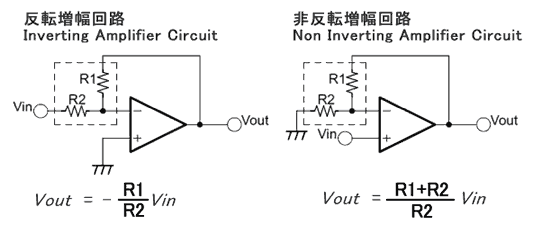Higher precision amplifier circuit
The following figure shows an inverting amplifier circuit and a non-inverting amplifier circuit using an operational amplifier. The amplifier gain is determined by the ratio of R1 to R2. To achieve the required gain without any adjustment, resistors for R1 and R2 must have small resistance tolerance and T.C.R. Accordingly, the Metal Film Type Resistor
RN73R, RN73H, the Wide Terminal Type Metal Film Flat Chip Resistor
WN73H, and the High Reliability Chip Resistor
RS73 series, are suitable.
Network resistors, chip resistors incorporating paired resistors, work in this application as well. Building two resistors concurrently achieves excellent relative accuracy and T.C.R. In fact, KOA‘s Network Resistor,
CNN2A, has two embedded resistors with the individual T.C.R. of
±25x10-6/K, which is 5x10
-6/K or less in relative. In addition,
KPC series has two or more resistors in one package, which enables better relative precision and high density mounting.
